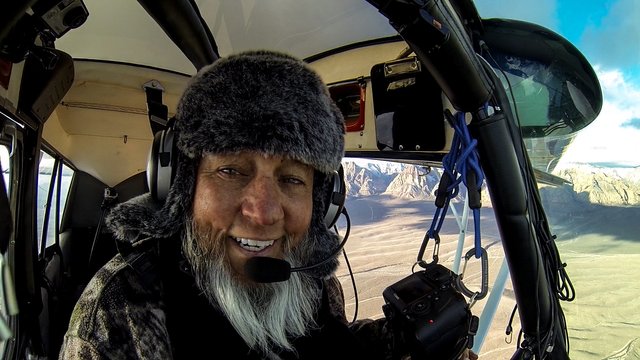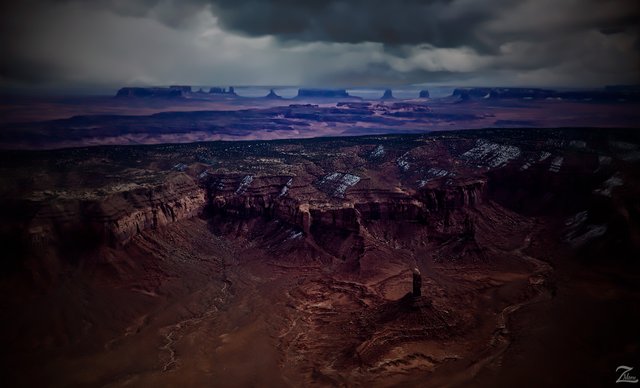Hoskinnini Mesa and Warrior Rock in Monument Valley
In the foreground is Hoskinnini Mesa with a lone towering Hoodoo formation standing strong against the elements in the bottom of this image. To the right of the Hoodoo is Copper Creek. In the background is the mystical and spiritually inspiring Monument Valley, (“Tsé Biiʼ Ndzisgaii”, for "valley of the rocks").
Taken late in the afternoon while flying and skirting around a storm in the Four Corners area in Utah along the Arizona border, this shows the mysterious and otherworldly landscape of Monument Valley. This ancient landscape is located on the First Nations Navajo (Diné) Tribal Reservation.
Hoskinnini Mesa is located west of Monument Valley near Kayenta. It was named after the much respected Diné leader, Hashké neiní, who was born in the Monument Valley area.Hashké neiní (Diné for" The Angry One" ) is known for his resistance to being forcibly removed during the unfortunate events of 1864 when Kit Carson begin his cruel campaign, now referred to as the “Long Walk”. (Research Source)
Union Army soldiers removed the Diné from their traditional ancestral homelands in the Four Corners Region and made them walk over 300 miles to a new reservation established by the Federal Government in eastern New Mexico known as Bosque Redondo.
The march was one that was very difficult and pushed many Diné to their breaking point, even death. The distance itself was cruel, and the fact that they did not receive any aid from the soldiers was devastating. Very few Diné were in prime condition to trek 300 miles, and many began the walk exhausted and malnourished while others were not properly clothed nor in the least prepared for such a long and harsh journey.
At least 200 died during the 18-day, 300-mile (500-km) trek.
Hashké neiní and his band evaded capture by the soldiers and lived for four years in the Navajo Mountain region in Utah. He became known as the "Emperor" of Monument Valley. While in hiding, Hashké neiní discovered a silver mine. This discovery helped he and his family to become wealthy and they made ornaments out of the silver from the mine.
Allegedly he was the first Diné Tribesman to own a turquoise necklace.In 1868 after the Diné were finally released and allowed to return to their ancestral homelands, Hashké neiní became known for his generosity to those who had survived their internment at Bosque Redondo. He died in 1912 in Monument Valley.
(Research Source)
I like this image of Hoskinnini Mesa because of that lonely Hoodoo tower in the lower part of the picture.
I like to imagine this as a beautiful symbol of Hashké neiní, standing strong and proud, surviving through time, shaped by the elements.
This image is from my ongoing project in which I am trying to raise awareness of the 47% of the USA and 90% of Canada that remain unpopulated wilderness.
Where Eagles Fly - The American Wilderness Expedition is my personal mission to introduce people to these amazing locations that surround us.

If you like what you see here upvote then resteemit so that others may experience these wondrous places as well. And if you'd like these images to be part of your feed then follow me.
Yehaw!!

amazing post
Amazing pictures and made even more so by your addition of the historical facts concerning the history of the Diné and what was done with them. The story of Hashké neiní caps it off in grand fashion! I have to say that I too most like the lone hoodoo! Thank you for posting and giving that snippet of history also! Resteemed and upvoted!